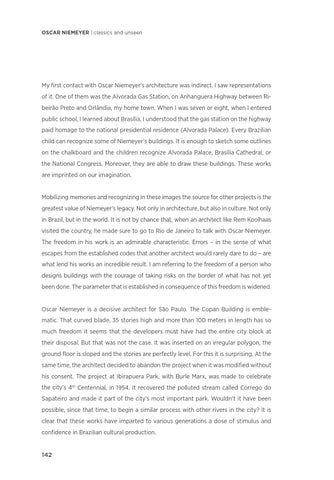OSCAR NIEMEYER | classics and unseen
My first contact with Oscar Niemeyer’s architecture was indirect. I saw representations of it. One of them was the Alvorada Gas Station, on Anhanguera Highway between Ribeirão Preto and Orlândia, my home town. When I was seven or eight, when I entered public school, I learned about Brasília. I understood that the gas station on the highway paid homage to the national presidential residence (Alvorada Palace). Every Brazilian child can recognize some of Niemeyer’s buildings. It is enough to sketch some outlines on the chalkboard and the children recognize Alvorada Palace, Brasília Cathedral, or the National Congress. Moreover, they are able to draw these buildings. These works are imprinted on our imagination. Mobilizing memories and recognizing in these images the source for other projects is the greatest value of Niemeyer’s legacy. Not only in architecture, but also in culture. Not only in Brazil, but in the world. It is not by chance that, when an architect like Rem Koolhaas visited the country, he made sure to go to Rio de Janeiro to talk with Oscar Niemeyer. The freedom in his work is an admirable characteristic. Errors – in the sense of what escapes from the established codes that another architect would rarely dare to do – are what lend his works an incredible result. I am referring to the freedom of a person who designs buildings with the courage of taking risks on the border of what has not yet been done. The parameter that is established in consequence of this freedom is widened. Oscar Niemeyer is a decisive architect for São Paulo. The Copan Building is emblematic. That curved blade, 35 stories high and more than 100 meters in length has so much freedom it seems that the developers must have had the entire city block at their disposal. But that was not the case. It was inserted on an irregular polygon, the ground floor is sloped and the stories are perfectly level. For this it is surprising. At the same time, the architect decided to abandon the project when it was modified without his consent. The project at Ibirapuera Park, with Burle Marx, was made to celebrate the city’s 4th Centennial, in 1954. It recovered the polluted stream called Córrego do Sapateiro and made it part of the city’s most important park. Wouldn’t it have been possible, since that time, to begin a similar process with other rivers in the city? It is clear that these works have imparted to various generations a dose of stimulus and confidence in Brazilian cultural production. 142
